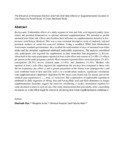The Influence of Antenatal Oral Iron and Folic Acid Side Effects on Supplementation Duration in Low-Resource Rural Kenya: A Cross-Sectional Study
Date
2020-05-11Author
Oiye, Shadrack
Juma, Margaret
Konyole, Silvenus
Adan, Fatuma
Metadata
Show full item recordAbstract
Background. Undesirable effects of a daily regimen of iron and folic acid ingested jointly (iron-folate) are potential disincentives to optimal antenatal supplementation. We intended to profile antenatal iron-folate side effects and elucidate their influence on supplementation duration in low-resource rural Kenya. Methods. This was a cross-sectional descriptive study of randomly selected postnatal mothers of under-five-year-old children. Using a modified WHO Safe Motherhood Assessment standard questionnaire, they recalled the total number of days of antenatal iron-folate intake and the attendant supplement-attributed undesirable experiences. The analyses considered only participants who ingested the supplements in their immediate last pregnancies (). Results. About half of the study participants reported at least a side effect and a mean of 2.4 (SD 1.5) effects per person in the entire pregnancy period. Most common reported effects were chest pains (31.8%), constipation (28.5%), severe stomach pains (11.6%), and diarrhoea (11.6%). Mothers who reported at least a side effect ingested the supplements for ten days less compared to those who did not experience any effect (); and a greater proportion of the former were primigravida () and used combined form of iron and folic acid (). In a multivariate analysis, significant correlations with supplementation compliance (ingestion for 90+ days) were found only for nausea and severe stomach pain experiences (, ; , , resp.). Conclusions. The commonness of undesirable experiences attributed to daily ingestion of 60 mg iron and 0.4 mg folic acid and their deterrence to longer supplementation durations suggest the need for considering a weekly intermittent regimen for some antenatal women in such set-ups. Our study demonstrated that potentially, more counselling on nausea as a side effect might be critical in advancing iron-folate supplementation compliance.
URI
https://doi.org/10.1155/2020/9621831https://www.hindawi.com/journals/jp/2020/9621831/
http://r-library.mmust.ac.ke/123456789/1549
Collections
- Gold Collection [1026]

